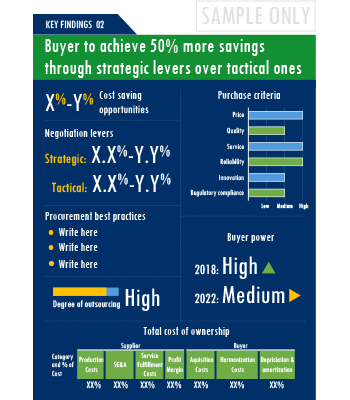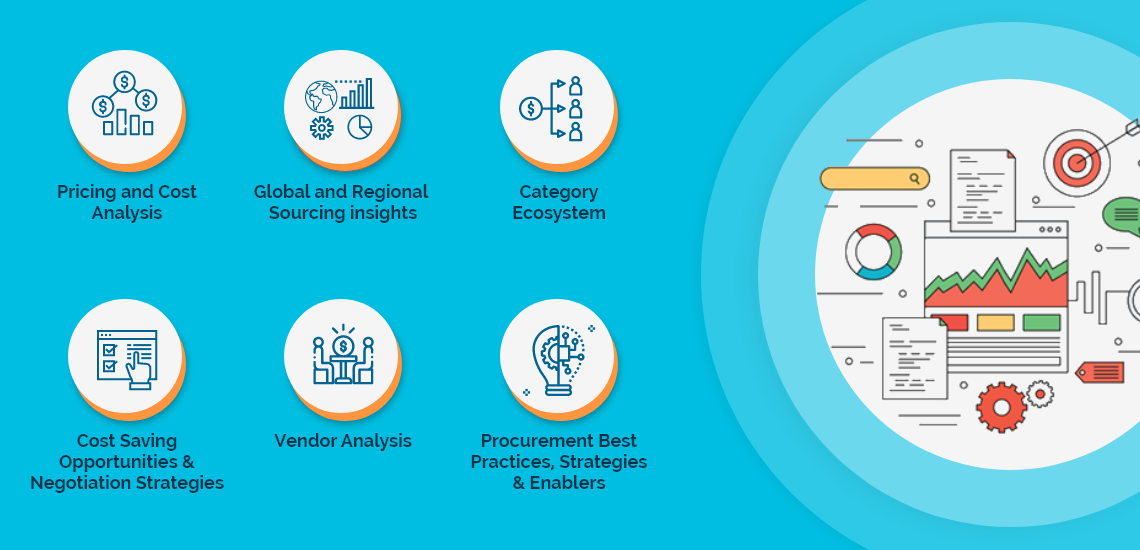A purchasing guide for Textile Printing – rich advisory on spend outlook in Textile Printing, pricing analysis for Textile Printing procurement cost benchmarking, negotiation strategies and key vendors of Textile Printing.
GET FREE SAMPLETextile Printing is an essential part of the Printed Products category which includes all spend related to the provision of printed products that may be required to carry out daily operations, promotional activities or special events. The spend may encompass books, booklets, brochures, leaflets, business stationery, cards, forms, labels, manuals, maps, pictures, publications, secure printing, tags, transfers and tickets.
The market for Printed Products and its sub-segments such as Textile Printing are at an interesting intersection. High procurement costs put a hindrance for buyers looking for upgrading or replacing a printing asset. As an alternative, suppliers are offering cost-effective re-engineering capabilities such as retrofitting of existing equipment with new systems.Digital printing has made significant in-roads at the expense of offset printing owing to its benefits such as order flexibility, optimized stock handling, and minimization of time-to-market for printed content.Rapid digitization of workspace and work processes has significantly reduced the use of paper in corporate world and therefore, industry has seen a consistent decline of print volumes. Still, the term \"paperless office\" will take years to become a common phenomenon. Print is here to stay and will co-exist with the digital document solutions in a \"paper-light\" corporate world.Trends like these and many others discussed in this report are necessitating a relook at the way Textile Printing is procured and the procurement cost saving opportunities that exist.
Textile Printing procurement best practices are moving towards a level of sophistication which is typically seen in traditional procurement categories. Category managers now have an attractive opportunity to adapt the best practices seen within this category as well as those being leveraged in other non-related categories. This report summarizes the best practices picked from across multiple categories that could work well for category managers involved with Textile Printing procurement strategy. For example, Buyers would benefit from engaging with service providers that display a high level of adoption of technologies such as web-to-print, workflow automation software, and remote proofing. These technologies would, in turn, enable buyers to achieve savings in their printing budgets, improve print quality, provide better visibility over the printing project, and offer greater flexibility over the printing project. Buyers should engage with service providers that offer binding and finishing services in a short TAT. This helps in eliminating issues related to scoring, folding, perforating, and binding within the digital printing process. Buyers must clearly define clauses pertaining to the ownership of subcontracted services that are not part of their service providers' portfolios. This is necessary to ensure service consistency and control over sensitive data that are shared with sub-contracted firms.
Activate your free account to gain easy access to cutting edge research and insights on consumers, emerging price trends, global and regional suppliers.
Textile Printing procurement managers also need to proactively identify and mitigate potential risks that can arise in the supply chain or contracts for Textile Printing procurement. Some examples include:
For detailed insights and complete access to our report library, activate your free account!
The report is intended to serve as a one-stop reference guide for Textile Printing procurement strategy and offers a perfect blend of category basics with deep-dive category data and insights. Therefore, it is ideal for category beginners looking for “Textile Printing: Procurement Report 101” as well as for category experts actively tracking the global Textile Printing procurement market.
You may have just initiated your research to design a winning Textile Printing procurement strategy, or you may be a category expert looking for strategic insights and updated data.Either ways, the report has your requirements covered.

Unlock SpendEdge's comprehensive procurement report collection with ease through our procurement platform.
Procurement decisions can prove to be costly in the absence of careful deliberation and evaluation of every available option. In fact, more than 90% of the decision makers we work with acknowledge that timely availability of up-to-date category intelligence can help them make better purchasing decisions. More than 80% of them believe that in-house category intelligence needs to be updated periodically to achieve full benefits. If you have read so far, we are quite sure you agree!!
The Textile Printing procurement report helps take more informed decisions by placing all the critical information and advice at the fingertips of a decision maker. It also specifically answers some of the key questions that we have been routinely asked during our industry outreach initiatives:
SpendEdge Insights has helped procurement professionals and sourcing teams manage multiple spend areas and achieve more than $2 billion in savings. Activate your free account today!
The Textile Printing market report offers a complete picture of the supply market and analyzes the category from the perspective of both buyers and suppliers. Analysis of the category trends, procurement best practices, negotiation levers and overall category management strategy advisory are interspersed with in-depth data and commentary on spend outlook, pricing ecosystem and supplier landscape drilled down to a region-level coverage.

A key highlight of this report is the in-depth outlook created on Textile Printing procurement spend and pricing trends. The report further delves deep into the aspects of cost structure, total cost of ownership and supplier margins for Textile Printing. A dedicated section to supplier profiles and evaluation helps decision makers cast a wider procurement net and identify gaps in existing relationships.

Along with specific category and supplier intelligence, the publication also includes curated insights on Textile Printing market trends, price influencers and inherent risks. These insights help the decision makers prepare for market shaping trends in advance and create alternative strategies for changes in the market conditions.

Additionally, the report also advises on the best practices and strategies to manage the Textile Printing category efficiently. Negotiation levers and opportunities are explained in detail along with quantification of their potential. Benchmark KPIs for supplier and buyer performance management are also aggregated to better organize the category objectives. Other themes of advisory include ideal procurement organization structure, enablers to achieve KPIs or category objectives and ideal SLAs to have with suppliers.






Our research is complex, but our reports are easy to digest. Quantitative analysis and exhaustive commentary is placed in an easy to read format that gives you an in-depth knowledge on the category without spending hours to figure out “what does it mean for my company?”


SpendEdge presents a detailed picture of Textile Printing procurement solutions by way of study, synthesis, and summation of data from multiple sources. The analysts have presented the various facets of the market with a particular focus on identifying the key category influencers. The data thus presented is comprehensive, reliable, and the result of extensive research, both primary and secondary.

Global Plain Labels Market - Procurement Intelligence Report

Global Tamper-Evident Labels Market - Procurement Intelligence Report

Global Printed Forms Market - Procurement Intelligence Report

Global Board Printing Market - Procurement Intelligence Report

Global Packaging Inserts Market - Procurement Intelligence Report

Global Inserts Market - Procurement Intelligence Report

Global Business Form Printing Market - Procurement Intelligence Report

Global Booklets Market - Procurement Intelligence Report

Global Corporate Stationery Market - Procurement Intelligence Report
Access this report and our entire procurement platform | Plans starting from USD 3000/ Year Buy Now
Copyright © 2025 Infiniti Research Limited. All Rights Reserved. Privacy Notice – Terms of Use – Sales and Subscription
Cookie Policy
The Site uses cookies to record users' preferences in relation to the functionality of accessibility. We, our Affiliates, and our Vendors may store and access cookies on a device, and process personal data including unique identifiers sent by a device, to personalise content, tailor, and report on advertising and to analyse our traffic. By clicking “I’m fine with this”, you are allowing the use of these cookies. You may change your settings based on a legitimate interest at any time, by selecting “Manage Settings” on our site. Please refer to the help guide of your browser for further information on cookies, including how to disable them. Review our Privacy & Cookie Notice.
